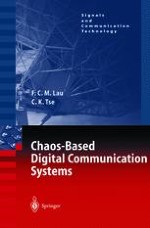2003 | OriginalPaper | Buchkapitel
Coexistence of Chaos-Based and Conventional Spread-Spectrum Systems
verfasst von : F. C. M. Lau, C. K. Tse
Erschienen in: Chaos-Based Digital Communication Systems
Verlag: Springer Berlin Heidelberg
Enthalten in: Professional Book Archive
Aktivieren Sie unsere intelligente Suche, um passende Fachinhalte oder Patente zu finden.
Wählen Sie Textabschnitte aus um mit Künstlicher Intelligenz passenden Patente zu finden. powered by
Markieren Sie Textabschnitte, um KI-gestützt weitere passende Inhalte zu finden. powered by
In this chapter we continue our investigation of the coexistence of chaos-based communication systems and conventional systems. As mentioned in the previous chapter, our motivation in performing this analysis is the possible co-operation of chaos-based and conventional systems under mutual interference. Specifically, being spread-spectrum, chaos-based communication systems are expected to perform reasonably well even in the presence of other wideband signals sharing the same bandwidth. Such a scenario may occur in normal practice, for example, when chaos-based systems are introduced while the conventional systems are still in operation. This aspect of performance is important, though it has rarely been addressed in the literature. It is therefore of interest to probe into the error performance of chaos-based systems in channels where other wideband communication systems coexist. Furthermore, it is useful to compare the relative performances of coherent and non-coherent chaos-based systems and the extent to which coherent systems excel in the presence of other coexisting wideband systems. Our objective in this chapter is to investigate the performance of selected chaos-based digital systems when their bandwidths are co-occupied by a conventional spread-spectrum signal. The chaos-based systems under study are the coherent CSK and the non-coherent DCSK systems, and the coexisting system is a standard direct-sequence spread-spectrum (DS-SS) system [Proakis and Salehi (1994); Ziemer and Tranter (1995)]. Analytical expressions for the bit error rates are derived in terms of system parameters such as spreading factor, chaotic signal power, conventional spread-spectrum signal power and noise power spectral density. Finally, computer simulations are performed to verify the analytical findings.
